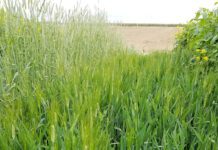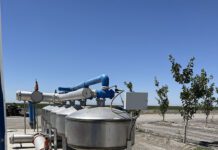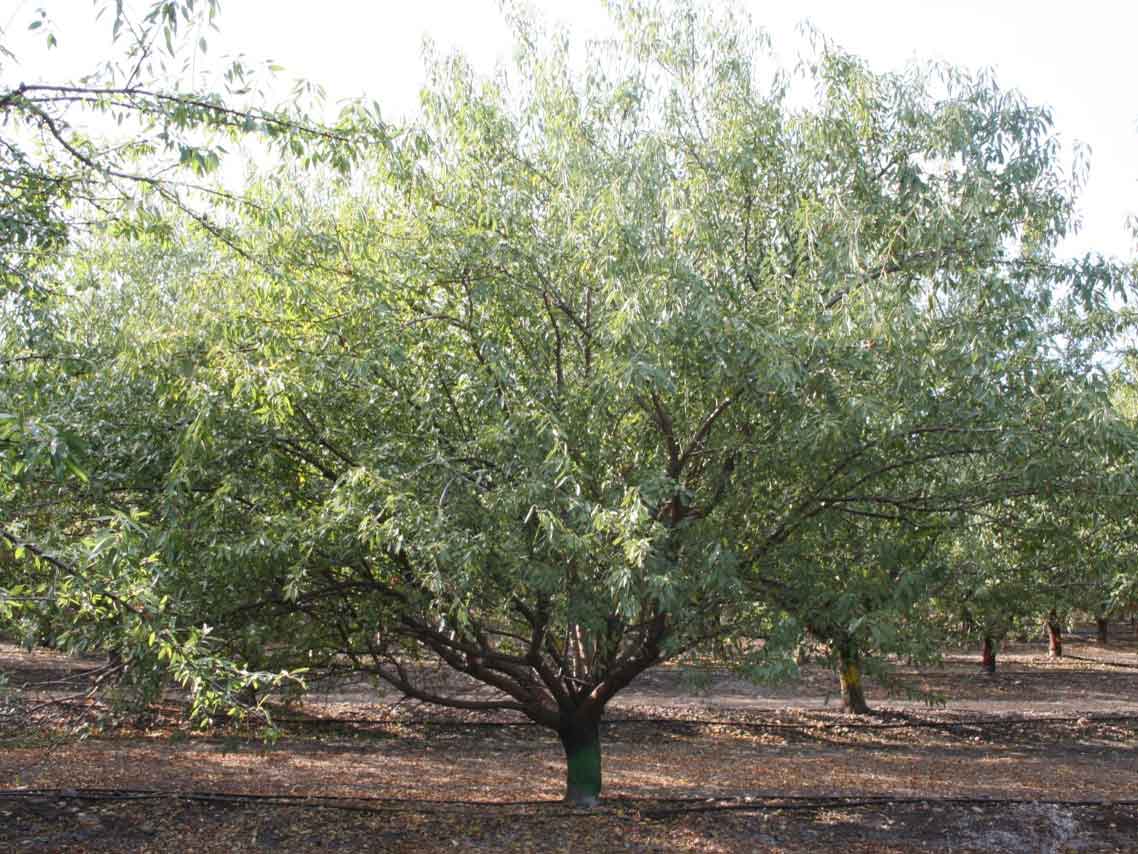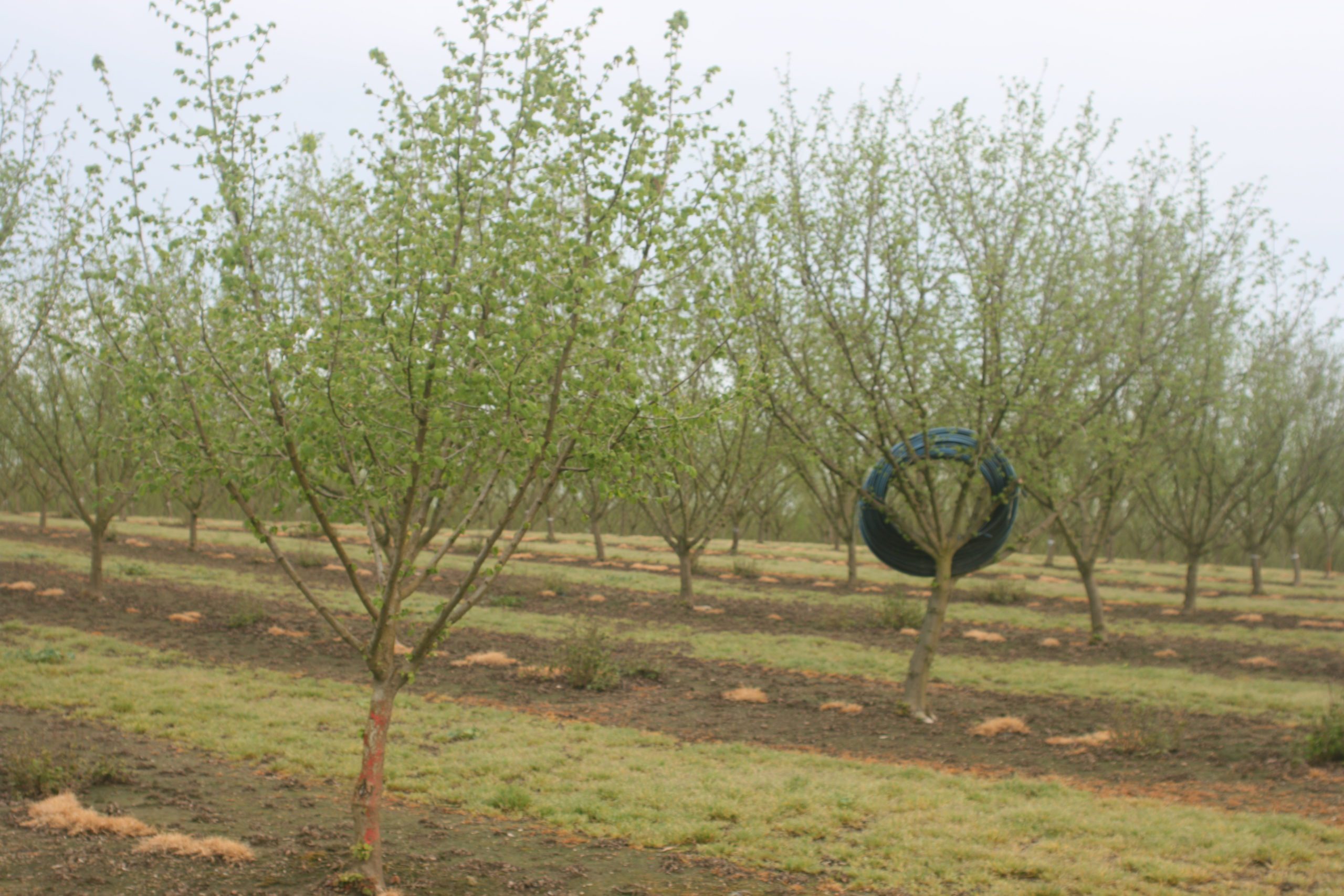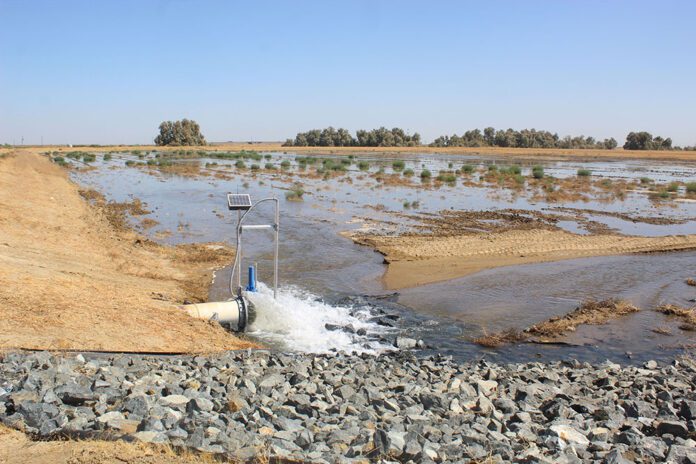
Listen to the audio version of this article. (Generated by A.I.)
California’s ongoing groundwater overdraft challenges are pushing growers, water managers and policymakers to find sustainable solutions that protect both agricultural productivity and rural communities. Groundwater levels in the San Joaquin Valley continue to decline, creating urgency around strategies such as on-farm recharge, smarter irrigation practices and collaborative planning.
These topics took center stage during a water recharge day co-hosted by American Pistachio Growers (APG) and Sustainable Conservation earlier this year, where experts, growers and officials discussed both the promise and challenges of restoring the state’s aquifers. The event underscored the shared goal of ensuring that California agriculture can thrive despite the mounting pressures of climate change and long-term water scarcity.
Groundwater remains the lifeblood of California farming, especially during drought years, when surface water is scarce. Yet, as Rogell Rogers, an agronomist with Sustainable Conservation, noted, decades of overdraft have left large portions of the Central Valley critically depleted.
With groundwater overdraft steadily worsening since the 1960s, Rogers warned that it’s an issue that can’t be treated as business as usual.
“We must document what we do when we talk on-farm recharge,” he said. “If we’re not documenting it, how do we show where we were, what we’ve accomplished, and how much more we can potentially achieve?”
On-farm recharge has emerged as one of the most cost-effective replenishment strategies available, and Rogers noted that using existing farm infrastructure makes on-farm recharge significantly less expensive compared to constructing dedicated basins. He also stressed that widespread collaboration among growers, agencies and researchers will be key to making meaningful progress.
“Recharge is not just about water; it’s about ensuring the future of agriculture in the Valley,” he added. “We all have a role to play in capturing water when it’s available and putting it back into the ground for the next generation.”
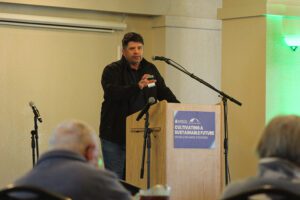
Balancing Water Budgets
Rogers’ call to action echoes the urgency expressed by water managers across the region. Stephanie Anagnoson, director of water and natural resources for Madera County, pointed out that groundwater use in some sub-basins far exceeds natural recharge, creating annual deficits and threatening long-term sustainability.
She said the best way to close this gap is through recharge projects.
“We need to capture water during wet years and store it underground to sustain farming and communities through dry periods,” Anagnoson said.
However, she said even the most robust recharge programs must be paired with demand reduction and careful management to meet long-term goals.
“Recharge alone won’t fix the problem,” she said. “We also need to manage groundwater extractions more carefully.”
“Cover crops can benefit on-farm recharge. Even though it might be less than the bare soil, the tradeoff for more soil water storage can offset the difference.” – Charlie Chen, UC Davis
Cover Crops and Water Dynamics
Winter cover cropping is gaining attention for its potential to improve soil health and influence groundwater recharge. Charlie Chen, a fourth-year Ph.D. student in the Hydrologic Sciences Graduate Group at UC Davis, under the mentorship of Professor Isaya Kisekka, is leading a study evaluating the impact of winter cover cropping in pistachio orchards through the UC Davis Agricultural Water Center.
“Our research shows cover crops can slightly increase water use during peak growth, but they also improve soil water retention and infiltration,” Chen said. “The tradeoff is that the improved soil health can benefit long-term groundwater recharge.”
Chen’s research compares two adjacent 30-acre pistachio blocks, one with cover crops and one without, using neutron probes to measure soil moisture and eddy covariance to track tree and cover crop water use.
“You can kind of think of it like a checkbook where you are balancing water instead of money. It can help keep track of how much water you are spending and saving,” he said.
While evapotranspiration (ET) was similar in both orchards during winter months, Chen observed differences later in the season.
“ET for the no-cover orchard was actually higher starting in July through October,” Chen said. “This demonstrates that cover crops are having impact on soil moisture when it acts as mulch to cover soil by reducing soil evaporation.”
To maximize the benefits and minimize the impact of cover crops on water use, the timing of cover crop termination will be the key management action. Earlier termination can reduce the water use of cover crops, potentially increasing soil water storage.
“Cover crops can benefit on-farm recharge,” he said. “Even though it might be less than the bare soil, the tradeoff for more soil water storage can offset the difference.”
Policy and Infrastructure Challenges
Legislative and regulatory hurdles remain a significant barrier to scaling recharge projects. Assemblymember Esmeralda Soria, D-Merced, has been a leading voice in Sacramento, pushing for policies that streamline permitting and improve the capture of floodwater for recharge.
“When flooding events occur, we must be able to capture and store that water instead of watching it flow out to the ocean,” Soria said. “We need to make smart investments and reduce unnecessary regulatory delays that are holding back recharge projects.”
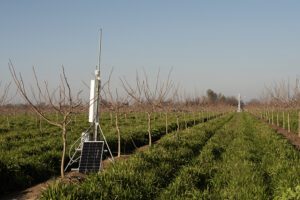
Panel Takeaways
A panel of growers, water district managers and legal experts at the recharge event underscored both the potential and the complexity of on-farm recharge. Merced Irrigation District shared how its combination of on-farm recharge and dedicated basins has enabled the district to store significant volumes of water during wet years.
Panelists also highlighted the legal gray areas surrounding recharge, noting that California law still does not classify recharge itself as a beneficial use of water, an issue that complicates long-term planning. Economic stressors such as fluctuating land values and financing challenges were also discussed as key hurdles for growers navigating Sustainable Groundwater Management Act (SGMA) requirements and an uncertain water future.
Growers Urged to Take a Seat at the Table
Joe Coelho, director of sustainability and member outreach for APG, said that water remains the No. 1 concern among growers.
“When I have these grower meetings, the first pain point that’s always presented are water woes,” Coelho said. “There’s a huge demand for water education and water outreach.”
APG partnered this year with Sustainable Conservation to host a series of water education days aimed at advancing on-farm recharge and promoting healthy soil practices. Coelho noted that these events are designed not only to share practical strategies but also to connect growers with policymakers, irrigation districts and groundwater sustainability agencies (GSA).
That connection, and the need for stronger outreach, was a recurring theme from the recharge event. One of the key takeaways from the day was the importance of grower engagement in decision-making processes that directly affect their water future.
“Not only have there been failures in outreach, there have been failures on the grower end in terms of us attending meetings where people are creating the pathway to our future,” Coelho said. “We’re here trying to be our best to be resilient, and this is a real effort toward that.”
He stressed that growers must be proactive in participating in SGMA-related meetings and local water planning efforts. As Anagnoson noted, too often GSA meetings lack grower presence, despite the fact that these forums directly shape the policies affecting agricultural water use.
A Path Forward
Experts agree that achieving groundwater sustainability in California will require a multifaceted approach of on-farm recharge, improved irrigation efficiency, infrastructure upgrades and strong collaboration between growers, agencies and policymakers. Documenting successes and scaling grower-led recharge projects will be essential to meeting SGMA’s 2040 sustainability goals.
As Rogers put it, recharge isn’t just an environmental solution.
“It’s a practical way to ensure the viability of farms, communities and the future of California agriculture,” he said.

Kristin Platts | Digital Content Editor and Social Correspondence
Kristin Platts is a multimedia journalist and digital content writer with a B.A. in Creative Media from California State University, Stanislaus. She produces stories on California agriculture through video, podcasts, and digital articles, and provides in-depth reporting on tree nuts, pest management, and crop production for West Coast Nut magazine. Based in Modesto, California, Kristin is passionate about sharing field-driven insights and connecting growers with trusted information.








